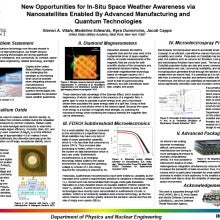New Opportunities for In-Situ Space Weather Awareness via Nanosatellites Enabled By Advanced Manufacturing and Quantum Technologies
Steven
Vitale
United States Military Academy
Poster
The explosive investment in quantum technology over the past decade is transforming the development of high-performance, low SWaP sensors. Meanwhile, advanced manufacturing technologies are driving significant progress in autonomy, artificial intelligence, and connectivity. By contrast, space-based systems value conservative engineering, reliable technology, and flight-proven hardware. Cadets at the United States Military Academy are challenging this paradigm by envisioning what could be possible when integrating advanced microelectronics manufacturing and quantum technologies into nanosatellites for persistent space weather awareness. Some examples include:
• Advanced microelectronics packaging reduces parasitic losses by shrinking inter-chip distances, enabling smaller power supplies, less thermal management, and less solar panel area without compromising functionality.
• New diamond quantum magnetometers combined with on-chip integrated photonics promise exquisite performance in a solid-state sensor package with a mass of a few grams and requiring milliwatts of power.
• A recently demonstrated micro electrospray thruster manufactured using semiconductor fabrication tools could provide SWaP-efficient propulsion on nanosatellites, which typically lack propulsion because conventional systems do not scale well to small sizes.
• Gallium oxide is a next-generation ultrawide bandgap material which may improve the sensitivity and response time for high energy particle detectors and solar-blind UV imagers, while exhibiting exceptional radiation hardness.
• Novel miniaturized scientific instruments will be enabled by 3D printing of high-quality inorganic dielectrics and metallic conductors, such as a recently demonstrated additively manufactured mass spectrometer which could quantify atomic oxygen in LEO.
These advancements promise smaller, more efficient, and cost-effective solutions for space weather monitoring, enhancing the capabilities of satellite systems and scientific instrumentation.
• Advanced microelectronics packaging reduces parasitic losses by shrinking inter-chip distances, enabling smaller power supplies, less thermal management, and less solar panel area without compromising functionality.
• New diamond quantum magnetometers combined with on-chip integrated photonics promise exquisite performance in a solid-state sensor package with a mass of a few grams and requiring milliwatts of power.
• A recently demonstrated micro electrospray thruster manufactured using semiconductor fabrication tools could provide SWaP-efficient propulsion on nanosatellites, which typically lack propulsion because conventional systems do not scale well to small sizes.
• Gallium oxide is a next-generation ultrawide bandgap material which may improve the sensitivity and response time for high energy particle detectors and solar-blind UV imagers, while exhibiting exceptional radiation hardness.
• Novel miniaturized scientific instruments will be enabled by 3D printing of high-quality inorganic dielectrics and metallic conductors, such as a recently demonstrated additively manufactured mass spectrometer which could quantify atomic oxygen in LEO.
These advancements promise smaller, more efficient, and cost-effective solutions for space weather monitoring, enhancing the capabilities of satellite systems and scientific instrumentation.

Poster PDF
Poster category
Ionosphere and Thermosphere Research and Applications
Meeting homepage